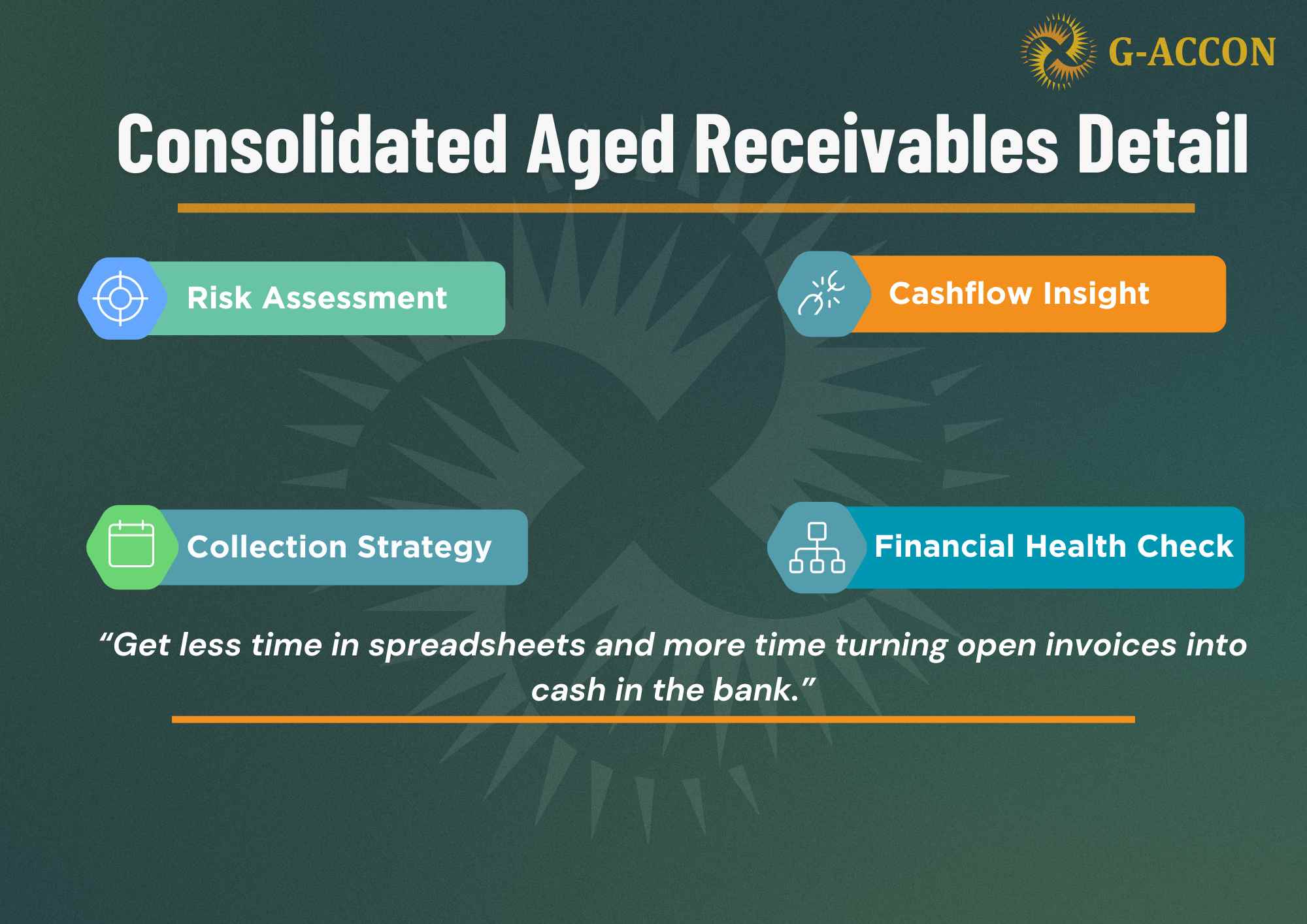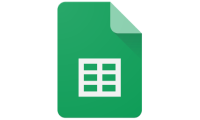When you sell on credit, you are doing your customers a favor. You give them time to pay so they can keep their own cash moving.
The problem is, many of them take that freedom a bit too far. One study found that nearly 68% of companies that get more than half of their payments late end up with cash flow problems. That is a big number, and it is not just a “large company” issue. It hits small firms and growing firms as well.
You cannot simply stop offering credit. If you do that, some customers will leave. So the real question is not “Should we offer credit” but “How do we stay on top of who owes us and how long they have owed us?”
That is where a Consolidated Aged Receivables Detail report comes in. And this is exactly the type of report G-Accon can help you build, refresh, and use every day.
Let us walk through what this report is, what it looks like in practice, and how G-Accon makes it much easier to manage across many entities or clients.
What is a Consolidated Aged Receivables Detail report?
You might already know the basic AR aging report. It groups unpaid invoices into time buckets like:
- Current
- 1–30 days
- 31–60 days
- 61–90 days
- Over 90 days
A Consolidated Aged Receivables Detail report takes that same idea but goes deeper and wider.
Deeper means it does not stop at totals. It shows each invoice line by line, including customer, invoice number, dates, and amount.
Wider means it brings together data from more than one company, region, or ledger into one view.
So instead of five separate aging reports sitting in five systems, you get one detailed report that tells you:
- Which customers owe you money
- Which invoices are past due, and by how much
- To which entity does the invoice belong?
- How the totals look by customer, by company, and by aging bucket
It is the “no hiding place” version of aging. Every invoice is there.
What this report usually includes
The exact layout can change from business to business, but most consolidated aged receivables detail reports will show:
- Customer name
- Company or entity the invoice belongs to
- Invoice number and date
- Due date
- Original invoice amount
- Amount still unpaid
- Aging bucket based on today’s date
- Currency if you work across countries
You can think of it as a table where each row is one invoice. You can sort by the oldest items, the largest balance, the riskiest customers, or the entities.
When this report is built across all your QuickBooks files, it becomes a powerful collection tool. You are not guessing anymore. You have the receipts right in front of you.
Why this level of detail matters
You might ask, “Why do I need detail if I already have an aging summary?”
The summary is great for high-level questions like:
- How much do we have outstanding in total
- What is our balance over 90 days
The detailed report helps you answer different questions, such as:
- Which invoices make up that 90+ balance for this customer
- Which entity is giving the customer the most credit
- Are there repeat late payers across more than one company
Collections work happens at the invoice level. Your team calls or emails about specific invoices, not just totals. So if you want to get paid faster, you need a clean, trusted list of those invoices with all the key fields.
That is what a consolidated aged receivables detail report gives you.
How teams build this report without G-Accon
Let us be honest. If you handle more than one company or region, doing this by hand is a grind.
A typical manual process looks like this:
- Log in to QuickBooks for Company A, run an aged receivables detail report, and export to Excel.
- Repeat for Company B, Company C, and so on.
- Open all the files, clean column names, fix date formats, and add a “Company” column.
- Copy everything into one master workbook.
- Add formulas, filters, and maybe a pivot table to group and sort.
- Hope nobody breaks those formulas.
- Do it all again next week or next month.
By the time you finish, the data is already a bit old. And if you are under pressure to chase cash, you do not want to spend hours just building a list before you can even start.
This is where G-Accon makes a clear difference.
How G-Accon helps you build Consolidated Aged Receivables Detail
G-Accon connects Google Sheets directly to your QuickBooks data. It lets you pull live information into a sheet, including detailed AR aging, and refresh it with a click or on a schedule.
Here is how that plays out for this report.
1. Connect all your entities
You connect each QuickBooks company to G-Accon. You can then pull accounts receivable data from multiple entities into one Google Sheet and tag each row with the company name.
You are no longer downloading separate files. You are pointing each query at the right company and letting G-Accon fill the sheet.
2. Pull detailed AR aging, not just a summary
Inside G-Accon, you choose the AR module and pull invoice-level data. You can include:
- Customer
- Invoice number
- Dates
- Amounts
- Status
- Company
In the sheet, you can add your own aging logic or use built-in fields if your accounting system already provides them. The result is a single, long table of all open invoices across all entities, ready to slice and filter.
Some G-Accon customers even use ready-made templates and then adjust columns and filters to match their own process.
3. Add consolidation logic once, then reuse it
Because all the data lives in Google Sheets, you can add formulas or pivot tables to:
- Group by customer across all entities
- Sum balances by aging bucket
- Highlight invoices over a set number of days
- Build a call list for the collections team
You only set this up once. The structure stays in place. When you refresh the data with G-Accon, the formulas update on their own.
4. Schedule refreshes and share the report
You can schedule G-Accon to refresh the data on a timetable. Daily, weekly, or around your month-end close.
Because the report sits in Google Sheets, you can share it with your team, management, or even external stakeholders with the right permissions. Everyone sees the same live data, not an old attachment sitting in someone’s inbox.
How your team can use Consolidated Aged Receivables Detail in real life
Once the report runs through G-Accon, it quickly becomes a daily tool, not a one-time project.
Here are some simple ways you can use it.
Sharpen your collection work.
You can filter the report to:
- Show all invoices over, say, 45 days
- Sort by largest balance
- Group by customer or region
That gives your collectors a clear list to work from. They can focus on the biggest and oldest items first. They can also see when one customer owes money to more than one entity, which changes that conversation.
Manage credit limits
If you see the same customer showing up in the older aging buckets month after month, you can:
- Review their credit limit
- Shorten their payment terms
- Ask for part payment before you ship more work
Because the report is consolidated, you can see if the customer is late with multiple companies at once. That is important when one branch thinks the customer is fine, but the group view says something else.
Support cash flow forecasts
Your finance team can use the detailed report to build better cash predictions. For example:
- Take all invoices in the “Current” and “1–30 days” buckets as likely near-term cash
- Apply a lower collection rate to “90+ days” invoices
- Track how much moves from one bucket to another over time
You move from rough guesses to data-backed estimates, based on real invoices and real history.
Help with audits and reviews
Auditors often want to see both the aging summary and the invoices behind it. With G-Accon and this detailed report, you can:
- Show the summary view by customer and bucket
- Click through to the raw data sitting in the same sheet
- Prove that the totals match what is in QuickBooks
That saves time for your team and keeps the audit conversation smoother.
Turning late invoices into a clearer, calmer process
Late payments will not disappear. Customers will still miss due dates, and some invoices will still drag into older buckets. You cannot remove that risk, but you can control how clearly you see it.
A Consolidated Aged Receivables Detail report gives you that clear view. It shows every unpaid invoice, across every entity, with the dates and numbers that matter. It helps you see patterns, spot problems early, and act with more confidence.
G-Accon helps you build and keep that report alive. You connect your QuickBooks companies, pull AR data into Google Sheets, add your aging and consolidation logic once, and then refresh it on a schedule. From there, your team can focus on calls, emails, and real conversations with customers, not on copying and pasting.
You get less time in spreadsheets and more time turning open invoices into cash in the bank.





















